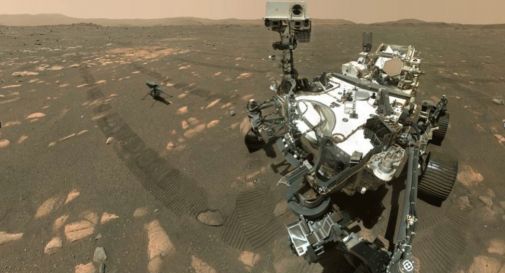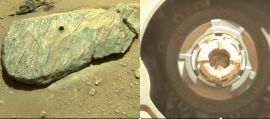Il Perseverance Rover della NASA compie il primo anno su Marte
A un anno dall'inizio della sua missione, il rover ha raccolto intriganti campioni di roccia e sedimenti marziani alla ricerca di possibili segni di vita
| Richard Brewer |

credito immagine NASA
USA — Un anno fa, il 18 febbraio 2021, il rover Perseverance della NASA è atterrato nel cratere Jezero, leggermente a nord dell'equatore marziano, per cercare segni di vita sul pianeta rosso. L'obiettivo è stato quello di raccogliere e conservare circa 30 campioni di sedimenti, roccia e atmosfera situati nell'antico delta del fiume, un ambiente che avrebbe potuto sostenere la vita, e conservare questi campioni per il futuro ritorno sulla Terra, dove possono essere studiati in dettaglio.
Ora, un anno dopo, il rover ha raccolto sei primi campioni di roccia marziana in assoluto, ma nessuno di questi proviene dalla destinazione finale, il delta del fiume stesso. Perseverance ha solo un anno rimanente per raggiungere il delta, raccogliere altri campioni e guidare fino al bordo del cratere dove li lascerà per una futura missione di ritorno di campioni sulla Terra. Il rover sta attualmente ripercorrendo la sua rotta verso il suo sito di atterraggio originale e ora si sta affrettando a raggiungere il delta entro aprile di quest'anno.
L'aspettativa originale era che il sito di atterraggio sarebbe stato entro 100 metri dal grande cumulo di sedimenti a forma di ventaglio che si riversò nel bacino del cratere circa 3,5 miliardi di anni fa... il delta del fiume. Ma quando il rover è sceso in superficie un anno fa, il sistema di navigazione autonomo di bordo lo ha guidato verso un atterraggio sicuro a circa 2,5 chilometri di distanza dall'altra parte di una regione sabbiosa e cosparsa di rocce che abbiamo chiamato Seitah (Navajo per 'in mezzo alla sabbia'). .
Ciò ha portato alla sorprendente scoperta che il pavimento di Jezero non era quello che ci si aspettava. Invece di atterrare sul fondo di un cratere fatto di sedimenti lacustri depositati nel tempo dal vento e dall'acqua, il rover si trovava su una superficie rocciosa fratturata e ignea prodotta vulcanicamente, formata dal magma di raffreddamento e chiaramente non dal fondo originale del cratere. credito immagine NASA
La roccia ignea, formata da lava molto calda che si è raffreddata e solidificata miliardi di anni fa, non è tipicamente il luogo in cui si cerca la vita. Tuttavia, quando gli scienziati hanno esaminato i dati dello strumento di Perseverance che hanno rivelato la composizione chimica delle rocce, è diventato chiaro che queste antiche rocce erano state alterate dall'acqua e l'interazione ha scavato piccoli tunnel e sacche piene di minerali salati che, sulla Terra sono perfetti per preservare i segni della vita. Queste rocce vulcaniche sono diventate inaspettatamente bersagli allettanti da campionare e conservare. Non solo un luogo ideale per cercare indicazioni di vita antica racchiuse nella roccia, possono fornire segni geologici dei campi magnetici passati e, analizzando gli elementi radioattivi al loro interno, determinarne l'età. Ciò consentirà agli scienziati di datare per la prima volta rocce da un luogo specifico sulla superficie di Marte, un entusiasmante vantaggio geologico in questa tappa del suo viaggio alla ricerca di indicazioni di vita passata.
La perseveranza ora si dirige verso l'antico delta del fiume. Durante il viaggio sarà guidato dall'intrepido elicottero "Ingenuity". Ingenuity è stata una storia di successo che ha soddisfatto e superato tutte le aspettative. È stato progettato come un esperimento e ci si aspettava che effettuasse solo cinque brevi voli se fosse stato fortunato, dimostrando che il volo era possibile nell'aria rarefatta di Marte. Ha invece effettuato 19 voli coprendo più di 3,8 km (2,4 miglia) ed è passato da esperimento a utile scout e compagno di Perseverance che aiuta a scegliere rotte sicure da seguire e identificare i siti che potrebbero essere esplorati.
Il prossimo anno di operazioni produrrà senza dubbio molte nuove entusiasmanti scoperte che miglioreranno la nostra conoscenza della superficie marziana e della sua storia. Nel frattempo, scienziati e ingegneri qui sulla Terra sono impegnati a progettare i sistemi di recupero e restituzione per riportare indietro i campioni che Perseverance è impegnata a fornire.
*************** IN ENGLISH ************
NASA's Perseverance Rover completes first year on Mars
USA — One year ago, 18 February 2021, the NASA Perseverance rover landed in Jezero Crater, slightly north of the Martian equator, to search for signs of life on the red planet. The goal has been to collect and store about 30 samples of sediments, rock and atmosphere located in the ancient river delta, an environment that could have supported life, and storing these samples for future return to Earth where they can be studied in detail.
Now, one year later, rover has collected six first ever Martian rock samples but none of them are from the ultimate destination, the river delta itself. Perseverance has only about one year remaining to get to the delta, collect more samples and drive to the crater rim where it will leave them for a future sample return to Earth mission. The rover is currently retracing its route back towards its original landing site and is now hurrying to get to the delta by April of this year.
The original expectation was that the landing site would be within 100 meters of the large fan shaped pile of sediments that washed into the crater basin about 3.5 billion years ago … the river delta. But as the rover descended to the surface a year ago the autonomous onboard navigation system guided it to a safe landing about 2.5 kilometers away on the other side of a sandy, rock strewn region we have named Seitah (Navajo for ‘amid the sand’).
This led to the surprising discovery that Jezero’s floor wasn’t what was expected. Instead of landing on a crater floor made of lake sediments deposited over time by wind and water, rover was on a fractured, igneous bedrock surface that was produced volcanically, formed by cooling magma and clearly not the original crater floor.
Igneous rock, formed by very hot lava that cooled and solidified billions of years ago is not typically where a search for life would be made. However, as the scientists examined instrument data from Perseverance that revealed the chemical composition of the rocks, it became clear that these ancient rocks were altered by water and the interaction excavated small tunnels and pockets that filled with salty minerals which, on Earth are perfect for preserving signs of life. These volcanic rocks have unexpectedly become tantalizing targets to sample and store. Not only an ideal place to look for indications of ancient life housed in the rock, they can provide geologic signs of past magnetic fields and, by analyzing radioactive elements inside them, determine how old they are. This will enable scientists to date rocks from a specific place on the surface of Mars for the first time, an exciting geologic payoff on this leg of its journey to look for indications of past life.
Perseverance now heads toward the ancient river delta. On its way it will be guided by the intrepid little helicopter “Ingenuity.” Ingenuity has been a success story that has met and exceeded all expectations. It was designed as an experiment and was expected to make only five short flights if it was lucky, proving flight was possible in the thin Martian air. It has instead made 19 flights covering more than 3.8 km (2.4 miles) and has graduated from an experiment to a useful scout and companion to Perseverance helping choose safe routes to follow and identifying sites that might be explored.
The next year of operations will no doubt yield many exciting new discoveries that will enhance our knowledge of the Martian surface and its history. In the meantime, scientists and engineers here on Earth are busy designing the recovery and return systems to bring back the samples that Perseverance is busy providing.



















